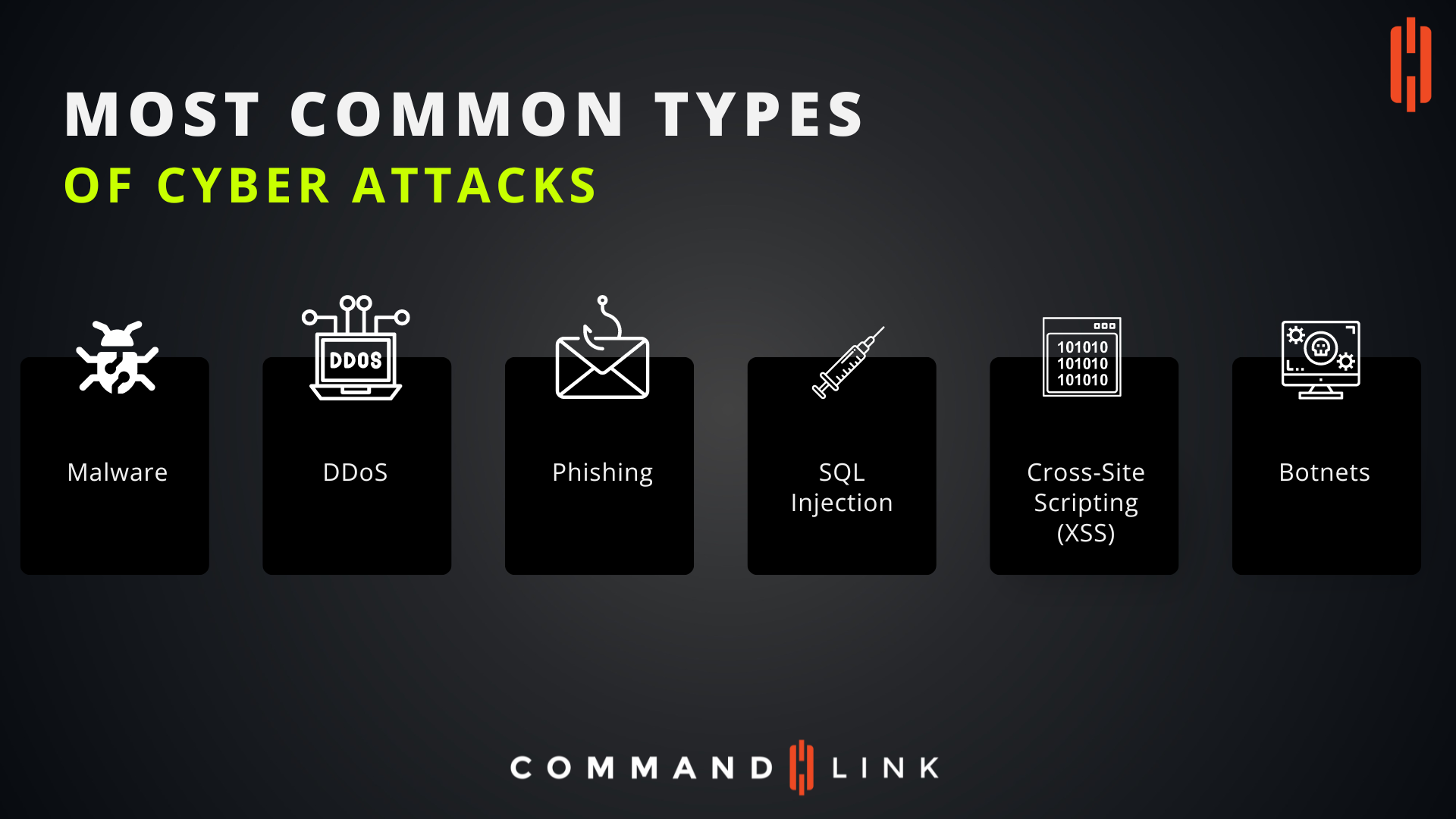Platform
Platform
Everything you need to run a secure global network—in a single system.
Solutions
Solutions
Learn how our solutions were designed to help you scale your IT resources
Company
CommandLink
Let's talk about how we can help you!
Partners

1. Malware
Malware, short for "malicious software," encompasses a variety of harmful programs designed to infiltrate, damage, or disrupt computers and networks. Common types of malware include viruses, worms, trojans, ransomware, and spyware. Malware can enter a system through email attachments, malicious websites, or infected software downloads.
Once inside, malware can cause significant damage by corrupting files, stealing sensitive data, or taking control of the system. For instance, ransomware encrypts a victim's files and demands payment for their release, while spyware monitors user activity and collects personal information without consent.
To defend against malware, organizations must deploy robust antivirus software, regularly update their systems, and educate employees about the risks of downloading and opening suspicious files.
2. Distributed Denial of Service (DDoS) Attacks
DDoS attacks aim to overwhelm a target's online services or network by flooding it with excessive traffic from multiple sources. This barrage of traffic consumes bandwidth and system resources, rendering the service unavailable to legitimate users. These attacks are typically carried out by botnets—a network of compromised computers controlled by an attacker.
DDoS attacks can disrupt business operations, cause financial losses, and damage an organization's reputation. They are often used as a form of protest or extortion, where attackers demand a ransom to stop the attack.
Mitigating DDoS attacks requires a combination of network security measures, including traffic filtering, rate limiting, and deploying DDoS protection services that can detect and absorb malicious traffic.
3. Phishing
Phishing is a social engineering attack where attackers impersonate a trusted entity to deceive individuals into divulging sensitive information, such as login credentials, credit card numbers, or personal identification details. Phishing attacks are commonly carried out via email, where victims are tricked into clicking on malicious links or opening fraudulent attachments.
These attacks are highly effective because they exploit human psychology, relying on fear, curiosity, or a sense of urgency to prompt victims to act. Phishing can lead to significant data breaches, financial losses, and compromised accounts.
To combat phishing, organizations should implement email filtering systems, conduct regular phishing simulations, and educate employees on how to recognize and report suspicious emails.
4. SQL Injection
SQL injection is a web application attack where an attacker inserts malicious SQL code into a query input field, exploiting vulnerabilities in the application's database. This allows the attacker to manipulate the database, accessing, modifying, or deleting data without authorization.
SQL injection attacks can result in unauthorized access to sensitive data, such as customer records or financial information, leading to data breaches and regulatory penalties. These attacks are often carried out through poorly secured web forms or user inputs that do not properly validate or sanitize input data.
Preventing SQL injection involves implementing input validation and parameterized queries, which ensure that user inputs are treated as data rather than executable code. Regular security assessments and code reviews can also help identify and fix vulnerabilities.
5. Cross-Site Scripting (XSS)
Cross-Site Scripting (XSS) is a vulnerability in web applications where an attacker injects malicious scripts into web pages viewed by other users. These scripts are typically executed in the victim's browser, allowing the attacker to steal session cookies, deface websites, or redirect users to malicious sites.
XSS attacks can have serious consequences, including data theft, unauthorized access to user accounts, and damage to an organization's credibility. There are two main types of XSS: stored (persistent) XSS, where the malicious script is permanently stored on the target server, and reflected (non-persistent) XSS, where the script is reflected off a web server, such as in a search result or error message.
To prevent XSS, developers must sanitize user inputs and encode output data, ensuring that scripts are not executed in the user's browser. Content Security Policies (CSP) can also help mitigate the impact of XSS by restricting the sources from which scripts can be executed.
6. Botnets
A botnet is a network of compromised computers, or "bots," that are controlled by an attacker, often without the knowledge of the device owners. Botnets are typically used to launch large-scale cyber attacks, such as DDoS attacks, spamming, or spreading malware.
The sheer size and distribution of botnets make them a powerful tool for cybercriminals. They can be used to perform automated tasks at an unprecedented scale, such as sending massive amounts of spam emails, cracking passwords, or mining cryptocurrency.
Defending against botnets requires a combination of strong endpoint protection, network monitoring, and the use of intrusion detection systems (IDS) to identify and block malicious traffic. Keeping systems patched and updated is also crucial in preventing devices from being compromised and added to a botnet.
Understanding the most common types of cyber attacks is the first step in building a robust cybersecurity strategy. By recognizing the methods used by attackers, organizations can implement effective defenses and minimize the risk of becoming a victim. Regular training, system updates, and the adoption of advanced security technologies are essential components of a proactive approach to cybersecurity. As the threat landscape continues to evolve, staying informed and vigilant will be key to safeguarding digital assets.